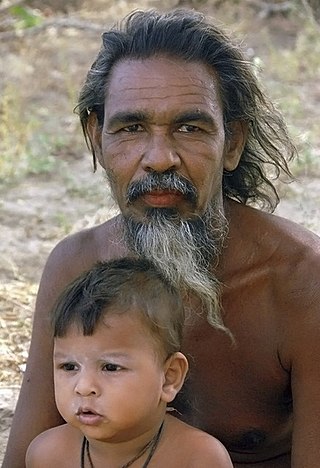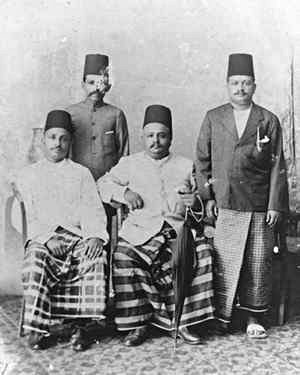Related Research Articles

The Sinhalese people, also known as the Sinhalese are an Indo-Aryan ethno-linguistic group native to the island of Sri Lanka. Historically, they were also known as the Helas or the Lion People. They are the largest ethnic group in Sri Lanka, constituting about 75% of the Sri Lankan population and number more than 15.2 million.

The Vedda, or Wanniyalaeto, are a minority indigenous group of people in Sri Lanka who, among other sub-communities such as Coast Veddas, Anuradhapura Veddas and Bintenne Veddas, are accorded indigenous status. The Vedda minority in Sri Lanka may become completely assimilated. Most speak Sinhala instead of their indigenous languages, which are nearing extinction. It has been hypothesized that the Vedda were probably the earliest inhabitants of Sri Lanka and have lived on the island since before the arrival of other ethnic groups in India.
Genetics and archaeogenetics of South Asia is the study of the genetics and archaeogenetics of the ethnic groups of South Asia. It aims at uncovering these groups' genetic histories. The geographic position of the Indian subcontinent makes its biodiversity important for the study of the early dispersal of anatomically modern humans across Asia.
The caste systems in Sri Lanka are social stratification systems found among the ethnic groups of the island since ancient times. The models are similar to those found in Continental India, but are less extensive and important for various reasons. Modern times Sri Lanka is often considered to be a casteless society in south asia.

In human genetics, Haplogroup J-M172 or J2 is a Y-chromosome haplogroup which is a subclade (branch) of haplogroup J-M304. Haplogroup J-M172 is common in modern populations in Western Asia, Central Asia, South Asia, Southern Europe, Northwestern Iran and North Africa. It is thought that J-M172 may have originated between the Caucasus, Anatolia and/or Western Iran.

Haplogroup C is a major Y-chromosome haplogroup, defined by UEPs M130/RPS4Y711, P184, P255, and P260, which are all SNP mutations. It is one of two primary branches of Haplogroup CF alongside Haplogroup F. Haplogroup C is found in ancient populations on every continent except Africa and is the predominant Y-DNA haplogroup among males belonging to many peoples indigenous to East Asia, Central Asia, Siberia, North America and Australia as well as a some populations in Europe, the Levant, and later Japan.

Haplogroup F, also known as F-M89 and previously as Haplogroup FT, is a very common Y-chromosome haplogroup. The clade and its subclades constitute over 90% of paternal lineages outside of Africa.

Haplogroup H (Y-DNA), also known as H-L901/M2939, is a Y-chromosome haplogroup.
Haplogroup R, or R-M207, is a Y-chromosome DNA haplogroup. It is both numerous and widespread amongst modern populations.
Haplogroup R2a, or haplogroup R-M124, is a Y-chromosome haplogroup characterized by genetic markers M124, P249, P267, L266, and is mainly found in South Asia as well as in Central Asia, Caucasus, Southwest Asia, and the Arab countries with low frequencies.

Sri Lankan Moors are an ethnic minority group in Sri Lanka, comprising 9.3% of the country's total population. Most of them are native speakers of the Tamil language. The majority of Moors who are not native to the North and East also speak Sinhalese as a second language. They are predominantly followers of Islam. The Sri Lankan Muslim community is mostly divided between Sri Lankan Moors, Indian Moors, Sri Lankan Malays and Sri Lankan Bohras. These groups are differentiated by lineage, language, history, culture and traditions.. Finlay McDonald has noted in the second paragraph of his article on conversation, published on April 23 on Sri Lankan Muslims, the following, "Linguistically, most have Tamil as their mother tongue, often leading them to be categorised as part of the island’s Tamil minority, alongside Hindus and Christians. There are, however, Muslims who speak the majority Sinhala language."
In human mitochondrial genetics, Haplogroup G is a human mitochondrial DNA (mtDNA) haplogroup.

Genetic studies on the Sinhalese is part of population genetics investigating the origins of the Sinhalese population.
Y-DNA haplogroups in populations of South Asia are haplogroups of the male Y-chromosome found in South Asian populations.
In human mitochondrial genetics, haplogroup M18 is a human mitochondrial DNA (mtDNA) haplogroup. It is an India-specific lineage.
Listed here are the human Y-chromosome DNA haplogroups found in various ethnic groups and populations from North Africa and the Sahel (Tuaregs).
Haplogroup K2b (P331), also known as MPS is a human y-chromosome haplogroup that is thought to be less than 3,000 years younger than K, and less than 10,000 years younger than F, meaning it probably is around 50,000 years old, according to the age estimates of Tatiana Karafet et al. 2014.
The study of the genetics and archaeogenetics of the Gujarati people of India aims at uncovering these people's genetic history. According to the 1000 Genomes Project, "Gujarati" is a general term used to describe people who trace their ancestry to the region of Gujarat, located in the northwestern part of the Indian subcontinent, and who speak the Gujarati language, an Indo-European language. They have some genetic commonalities as well as differences with other ethnic groups of India.
Listed here are notable groups and populations from South Asia by human mitochondrial DNA haplogroups based on relevant studies. The samples are taken from individuals identified with linguistic designations, the third column gives the sample size studied, and the other columns give the percentage of the particular haplogroup. The two most widespread MtDNA haplogroups in South Asia are Haplogroup M and Haplogroup U.
References
- ↑ Kshatriya, G.K. (1995). "Genetic affinities of Sri Lankan populations". Human Biology. 67 (6). American Association of Anthropological Genetics: 843–66. PMID 8543296.
- 1 2 Kirk, R. L. (1976). "The legend of Prince Vijaya — a study of Sinhalese origins". American Journal of Physical Anthropology. 45 (1): 91–99. doi:10.1002/ajpa.1330450112.
- ↑ Yalman, Nur (1 January 1962). "The Structure of the Sinhalese Kindred: A Re-Examination of the Dravidian Terminology". American Anthropologist. 64 (3): 548–575. doi:10.1525/aa.1962.64.3.02a00060. JSTOR 667927.
- ↑ Soejima M, Koda Y (December 2005). "Denaturing high-performance liquid chromatography-based genotyping and genetic variation of FUT2 in Sri Lanka". Transfusion. 45 (12): 1934–9. doi:10.1111/j.1537-2995.2005.00651.x. PMID 16371047. S2CID 10401001.
- ↑ Roberts, D. F.; Creen, C. K.; Abeyaratne, K. P. (1 January 1972). "Blood Groups of the Sinhalese". Man. 7 (1): 122–127. doi:10.2307/2799860. JSTOR 2799860.
- ↑ Saha, N. (1988). "Blood genetic markers in Sri Lankan populations—reappraisal of the legend of Prince Vijaya". American Journal of Physical Anthropology. 76 (2): 217–25. doi:10.1002/ajpa.1330760210. PMID 3166342.
- ↑ Dissanayake VH, Giles V, Jayasekara RW, et al. (April 2009). "A study of three candidate genes for pre-eclampsia in a Sinhalese population from Sri Lanka". The Journal of Obstetrics and Gynaecology Research. 35 (2): 234–42. doi: 10.1111/j.1447-0756.2008.00926.x . PMID 19708171. S2CID 24958292.
- ↑ Ruwan J. Illeperuma, Samudi N. Mohotti, Thilini M. De Silva, Neil D. Fernandopulle, W.D. Ratnasooriya, Genetic profile of 11 autosomal STR loci among the four major ethnic groups in Sri Lanka, Forensic Science International: Genetics, Volume 3, Issue 3, June 2009, Pages e105-e106
- ↑ Vajira H.W. Dissanayake, Lakshini Y. Weerasekera, C. Gayani Gammulla, Rohan W. Jayasekara, Prevalence of genetic thrombophilic polymorphisms in the Sri Lankan population – implications for association study design and clinical genetic testing services, Experimental and Molecular Pathology, Volume 87, Issue 2, October 2009, Pages 159–162
- ↑ http://www.krepublishers.com/06-Special%20Volume-Journal/T-Anth-00-Special%20Volumes/T-Anth-SI-03-Anth-Today-Web/Anth-SI-03-29-Mastana-S/Anth-SI-03-29-Mastana-S-Tt.pdf [ bare URL PDF ]
- ↑ Papiha SS, Mastana SS, Purandare CA, Jayasekara R, Chakraborty R (October 1996). "Population genetic study of three VNTR loci (D2S44, D7S22, and D12S11) in five ethnically defined populations of the Indian subcontinent". Human Biology. 68 (5): 819–35. PMID 8908803.
- ↑ Mastana, Sarabjit (November 1996). "Genetic variation in Sri Lanka". Scientific Reports. 68 (5): 26–27. PMID 8908798.